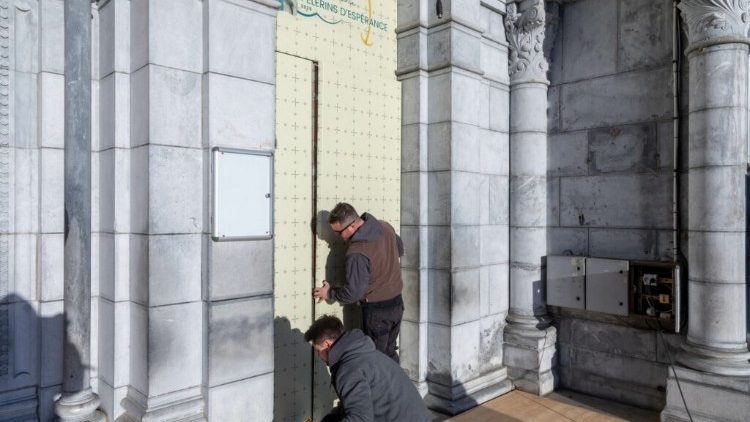Garments of Meaning: The Cappa Magna
In the year King Uzziah died, I saw the Lord seated on a high and lofty throne, with the train of his garment filling the temple. Seraphim were stationed above . . . (Is. 6:1-2) A train is the long, back portion of a robe, cloak, or dress that trails behind the wearer. A train […]



In the year King Uzziah died, I saw the Lord seated on a high and lofty throne, with the train of his garment filling the temple. Seraphim were stationed above . . . (Is. 6:1-2)
A train is the long, back portion of a robe, cloak, or dress that trails behind the wearer. A train is commonly found on women’s formal gowns or wedding dresses. Speaking of which . . .
Throughout my childhood, the 1965 movie musical The Sound of Music came on television every spring. And every spring I’d watch it in bits and pieces. Not that I really wanted to, mind you. You see, I had six sisters and only two brothers, one of whom was the baby and too young to vote on what got watched on TV back in the 1970s.
One Christmas in the 1980s, Santa delivered VHS tapes of The Sound of Music to be played on our new VCR player. The next spring, like clockwork, The Sound of Music came back on television. And my sisters watched it! I went into the living room, and I said, “Why are you watching this? You could watch this anytime you wanted on the VCR! Without commercials!” My sisters, all sitting in a row on the couch, stared blankly up at me, and then went back to staring at the TV, saying nothing.
I would argue a big part of the attraction of The Sound of Music, especially to girls, is the four-minute wedding scene. It begins with Julie Andrews kneeling and receiving a blessing from her former Mother Abbess from the monastery. Then she processes across a courtyard as the large outdoor bells peal away. As she enters the church, a German abbey founded in 748, the camera cuts away to the huge pipe organ being played. Then, with the camera above and behind Andrews, it follows her as she processes up the aisle. In a brilliant contrast of color, light from the windows hits her white dress and train as she appears to glide past the congregants in the pews, who are all dressed in dark formal attire.
When Andrews gets to the sanctuary, she takes her future husband’s hand, and they process up several steps and genuflect. As the bishop blesses them, the camera takes the viewer’s eyes up the magnificent high altar, full of flowers, candles, saints, and angels, all the way up to the ceiling, through the roof to the outdoor bells on the steeple, and out to the breathtaking Austrian countryside.
And so, young women watch this movie, the third highest grossing movie of all time, over and over again. They watch it in part because it brilliantly captures what most young women long for in their hearts—a beautiful wedding to the man they love.
Brides are not the only ones who dress in garments that include trains. Ancient kings and queens wore splendid vestments that had trains. Servants, “train bearers,” would walk behind them, carrying their trains. I’ve read that when kings conquered other kings, they would cut off the conquered king’s train and attach it to their own existing one.
For around 800 years, bishops wore silk trains called cappa magna (great cape) to add to the pomp and solemnity of festive occasions. I have an old photograph in the rectory of a Solemn Mass in 1943. Bishop Griffin of Springfield, IL, is present, celebrating the anniversary of a parish church. In the corner of the sanctuary, there is this tiny little boy sitting on a stool. It’s my father. The back of the photo says, “Train bearer, John Drew.”
In 1969, when Rome gave us a new order of things, it was decreed that the train, along with much of our Catholic tradition, was no longer obligatory. The train, the cappa magna, is seldom seen today, but when it makes a rare appearance, it provokes alarm and comments which include words like high-brow, worldly, peacock, rigid, and vain.
A disapproving deacon once blogged on the cappa magna:
I would be hard-pressed to imagine someone like Pope Francis—he, of the frayed sleeve and scuffed shoes—wearing this sort of vestment . . . If the pontiff believes bishops should smell like their sheep, it might be a challenge to find sheep who smell of watered silk.
Another deacon blogged:
I will always fail to see how it reflects the One who was carpenter turned preacher and healer. Could anything be farther from His simple garments?
Were bishops who wore those long trains in processions through the centuries acting vain? Were they peacocks? Or were they humble servants of something much greater than themselves? The train that trailed behind a bishop did indeed represent worldliness. But something that needs to be understood is that after the bishop entered the church and the liturgy started, the train was removed. The passing-away world with its false allurements was rejected for something much greater.
At Solemn Masses, the bishop had to stand there while ministers put layer after layer of vestments over him, so much so that he could barely move. Then throughout the liturgy, the ministers led the bishop around the sanctuary. The symbolism was clear: the bishop, standing in the person of Christ the High Priest, was the victim of the sacrifice, like a lamb led to the slaughter.
What do you think heaven is like? Do you think, if God-willing you arrive there, that Christ will meet you wearing frayed garments and scuffed shoes? Do you think He will say, “Just call me Jesus, because you’re in heaven now, and I’m no better than you”?
Don’t count on that.
Isaiah wrote that in heaven “the Lord sits on a high and lofty throne, and the train of His garment fills the temple as angels cry, ‘Holy, holy, holy is the Lord of hosts!’” The psalmist wrote, “in the presence of the angels I will sing your praise; I will worship at your holy temple.”
The Apostle John looked up and through an open door into heaven. He saw the Lord seated on His splendid throne surrounded by flashes of lightning and peals of thunder. Elders cast their crowns before the throne and sang:
Worthy art thou, our Lord and God, to receive glory and honor and power, for thou didst create all things, and by thy will they existed and were created.
On Calvary’s throne, Christ defeated all the false kings of this world. The trains of these conquered kings were then cut off and attached to Christ’s. That is why the train of His garment fills heaven—because He is the King of Kings. That is why bishops for all those centuries wore cappa magna, great capes, trains. Not to make us think of peacocks, but to make us think of heaven.
Do you think of heaven when you are present at Mass? Or do you always fail to see how it reflects the reality being played out?
The reality is that Holy Mass makes present a wedding that you cannot even begin to imagine. For it is not like an earthly wedding between a man and a woman. No, Christ is the Bridegroom, and we the Church are His bride. As the angel told the Apostle John in his vision of heaven:
Blessed are those who are invited to the marriage supper of the Lamb.
Why then did churches traditionally have high altars? So that at Mass people’s eyes could follow God’s high and lofty throne, full of flowers, candles, and angels, up to the ceiling, leading their thoughts beyond the roof, up to the breathtaking, heavenly countryside. This of course helped capture what all of us long for in our hearts—a beautiful wedding in heaven to the One we love.
Photo from Wikimedia Commons














